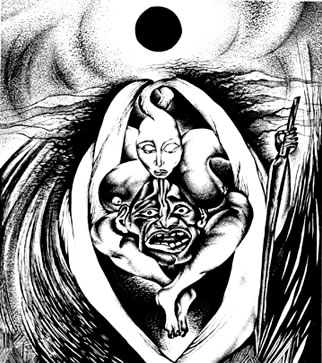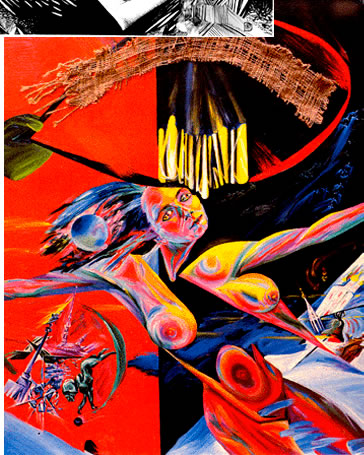 |
 |
|||||||||||||
 |
||||||||||||||
 |
||||||||||||||
GALLERY OF EARLY ART WORK
PAINTINGS DRAWINGS WATERCOLOURS PHOTOGRAPHS Definitive art work: Judith with the Head of Holofernes (inkdrawing, 1996) “Usually, the negative anima is depicted in the form of the femme fatale and finds expression in many of the paintings that I have briefly reviewed above, for example those of Gustav Klimt (Plate 1), Massys, Von Stuck and Metsys. However, none of these images express the fear of the woman’s castrating sexual potential quite as well as Irene Caesar’s 1996 inkdrawing (Plate 2), Judith with the Head of Holofernes… |
 |
|||||||||||||
 |
It is because Judith ‘usurps’ the male role (Dundes 1975:29) and so the male authority and prescription of what woman should be that she is both saint and murdering seductress, chaste, spiritual and carnal. It is also for this reason that she poses such a great threat to the male psyche, which baulks at the thought of a woman so powerful that she can easily beguile a powerful general and cut off his head. The head, being symbolic of the penal head, then conjures up images of the dreaded castration and concomitant loss of power, life and vitality. This element is clearly depicted in Irene Caesar’s drawing to which I referred earlier. The woman kills the man with her overpowering sexuality – note how the woman’s legs and hair surround the man in vulva formation – thus castrating him and subverting his authority, for it is she who is in control, not he" (Helen Efthimiadis-Keith, University of the North, Text and interpretation: Gender and violence in the Book of Judith, Scholarly Commentary and the Visual Arts from the Renaissance Onward, Old Testament Essays 15:1, pp. 70-71 – The analysis of Judith’s depiction by Botticelli, Donatello, Giorgione, Cranach the Elder, Caravaggio, Andrea Mantegna, Gustav Climt and Irene Caesar, pp. 64-84). helen_efthimiadis_keith_on_judith.pdf
|
|||||||||||||
 |
||||||||||||||